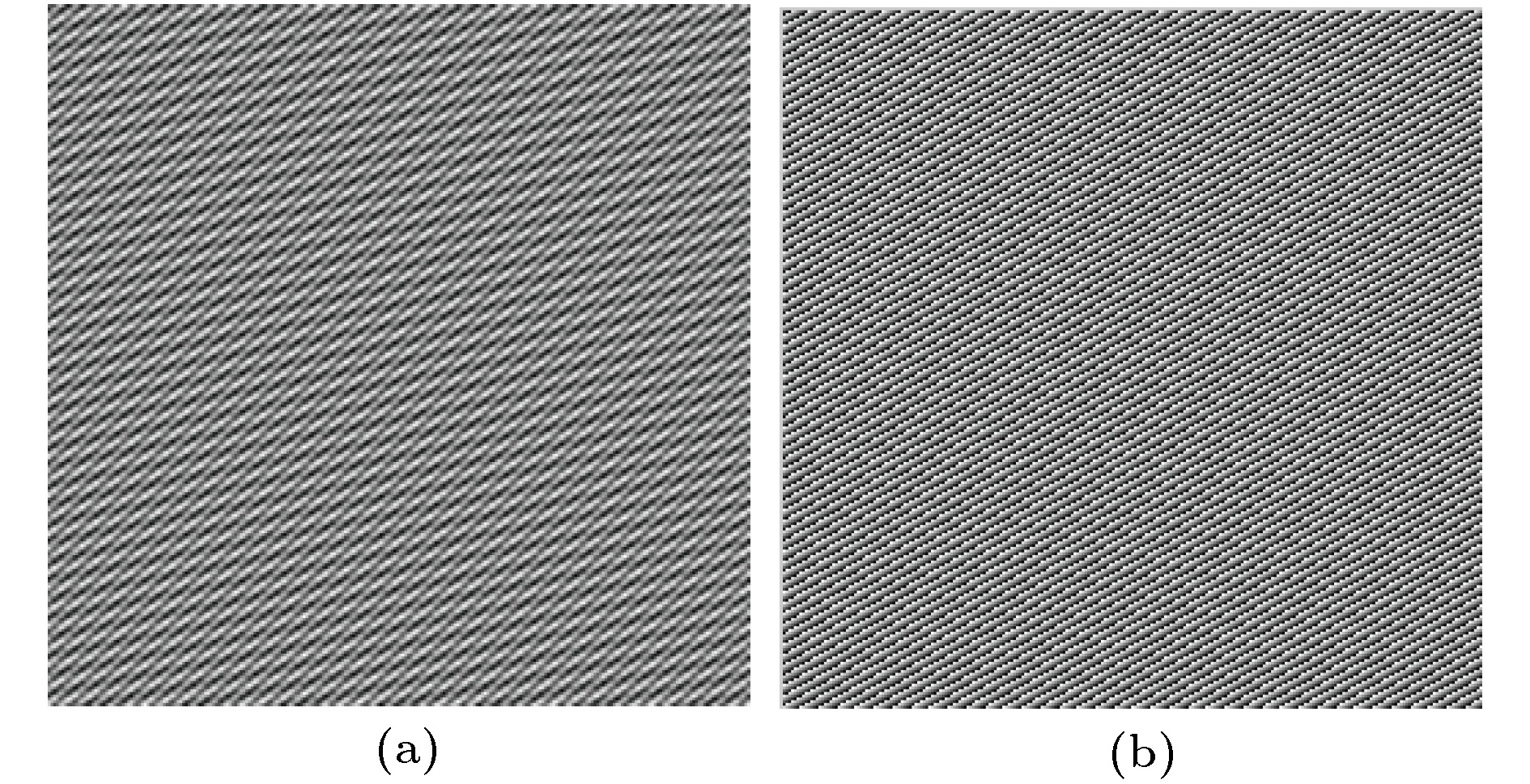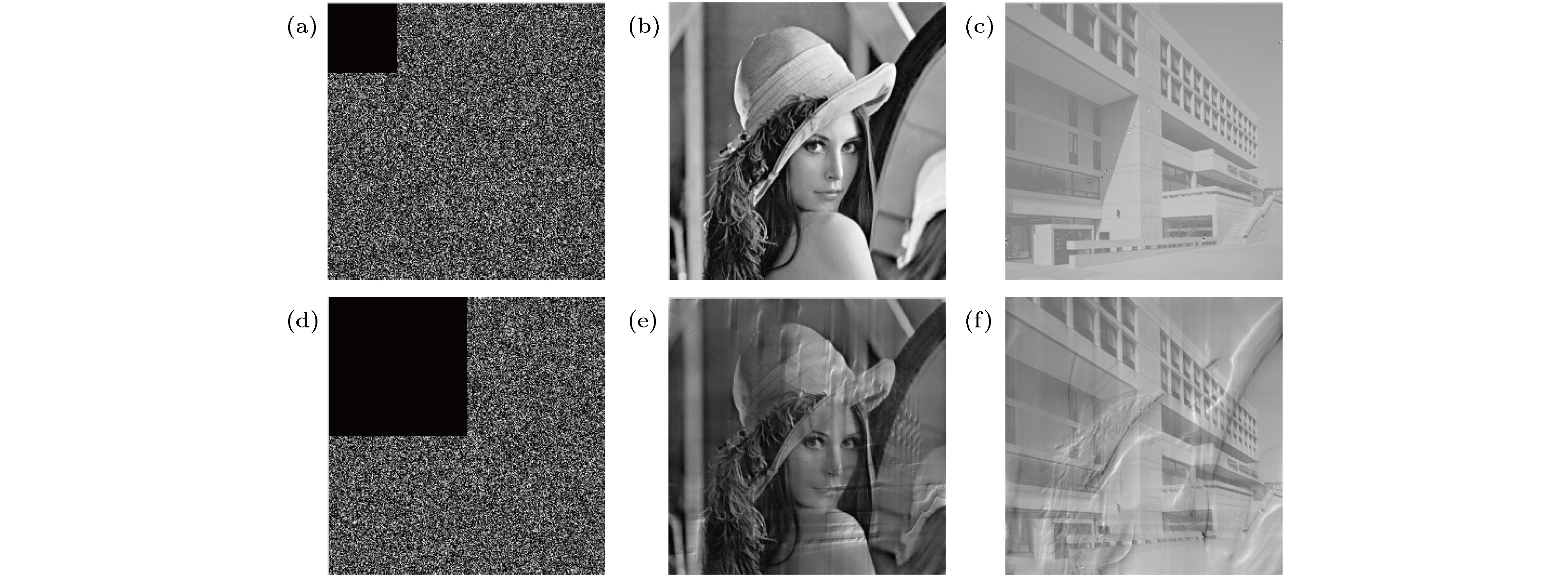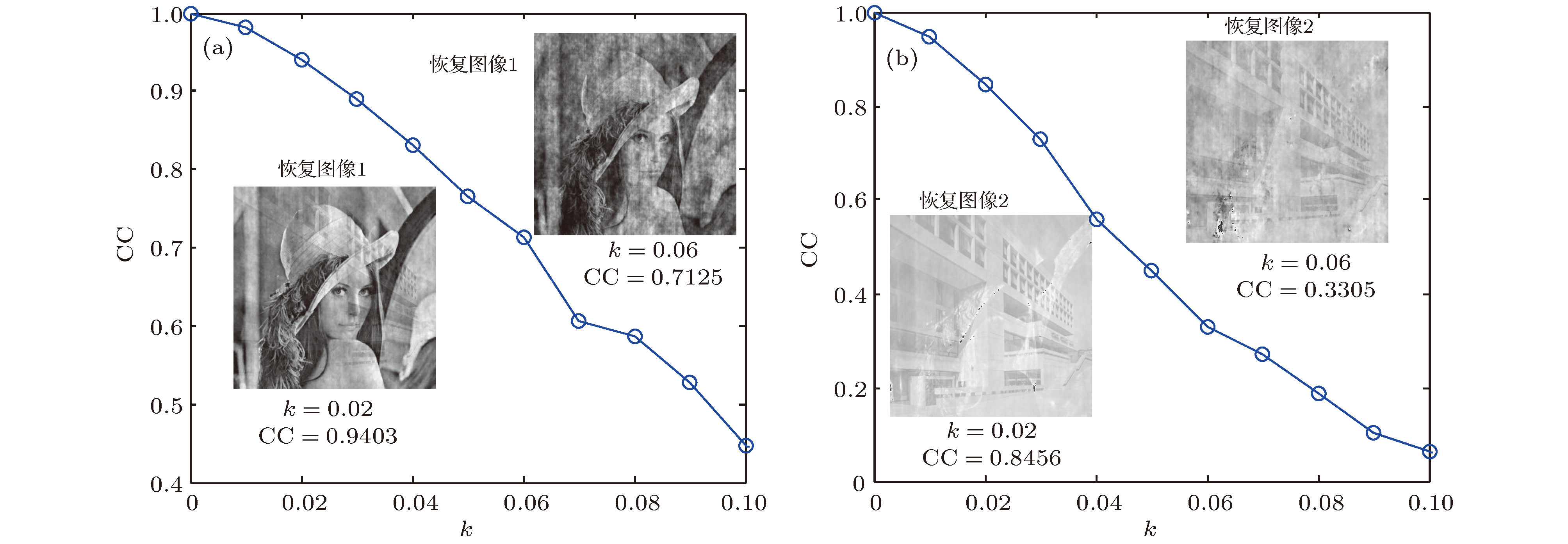-
基于Q-plate提出了一种对两幅图像做非对称偏振加密的新方法. 在该方法中, 首先, 将待加密的两幅图像通过干涉分解成两块纯相位板; 其次, 将这两块纯相位板分别编码到偏振光的两个正交分量中; 最后, 利用Q-plate和像素化的偏振片改变这束光的偏振分布, 达到对图像的加密效果, 用电荷耦合器件接收输出面的强度分布图作为最终的密文. 其中一块纯相位板作为解密密钥. 算法的解密密钥不同于加密密钥, 由此实现了非对称加密. 由于Q-plate是电调控的, 它的每个像素点的光轴各不相同, 所以能够根据描述变面结构空间旋转率的常数q来改变每个像素的偏振态. 加密过程中用Q-plate的q值和像素化的偏振片的偏振角度作为加密密钥, 这两个加密密钥具有很高的敏感性, 极大地提高了算法的安全性. 数值模拟结果验证了该方法的可行性和有效性.With the rapid development of computer network technology, information security has drawn considerable attention in recent years. Owing to the characteristics of multi-dimensional operation and parallel processing capability, optical image encryption techniques are arousing great interest in many exciting fields. Since the pioneering work on optical image encryption using double random phase encoding technique, a large number of algorithms and architectures have been proposed and realized. However, with the further analysis of the securities of these schemes, most of them have been verified to be vulnerable to different types of attack algorithms. Recently, optical encryption schemes based on the polarization properties of light wave have been extensively studied, for an additional flexibility in the encryption key design is provided, which can achieve high robustness against brute force attack by a combination of multiple private keys. Nevertheless, optical encryption schemes based on the polarization properties of light wave could still be vulnerable to known- and chosen- plaintext attacks. Therefore, in this paper, a novel asymmetric polarization encryption method is implemented for dual images, and combined with interference-based optical image encryption method and a Q-plate. First, the information about the two images to be encrypted is separated into two pure phase plates by means of interference optical image encryption, which will be further encoded into two mutually orthogonally polarized light beams. Next, the Q-plate and pixelated polarizer are used for realizing different polarization distributions of the two light beam. Ultimately, the output intensity distribution is recorded by a charge coupled device (CCD) which will be treated as the final ciphertext. For actualizing the asymmetric encryption, one of the pure phase plates acts as a decryption key, which is different from the encryption key. We can control the polarization state of each pixel according to the parameter q, causing the Q-plate to be electrically controllable and the optic-axis orientation of each pixel to differ from one another. It should be emphasized that the value of q and the polarization angle of the pixelated polarizer play the role of two encryption keys, which improves the security of the algorithm extremely, due to their high sensitiveness. Theoretical analyses and numerical simulations verify the feasibility and effectiveness of the proposed encryption scheme.
-
Keywords:
- Q-plate /
- asymmetric encryption /
- polarization
[1] Refregier P, Javidi B 1995 Opt. Lett. 20 767
 Google Scholar
Google Scholar
[2] Deng X P, Zhao D M 2012 Opt. Laser Technol. 44 136
 Google Scholar
Google Scholar
[3] Abuturab M R 2015 Opt. Lasers Eng. 69 49
 Google Scholar
Google Scholar
[4] Liu Z J, Guo C, Tan J B, Liu W, Wu J J, Wu Q, Pan L Q, Liu S T 2015 Opt. Lasers Eng. 68 87
 Google Scholar
Google Scholar
[5] Sui L S, Xin M T, Tian A L, Jin H Y 2013 Opt. Lasers Eng. 51 1297
 Google Scholar
Google Scholar
[6] Chen W, Chen X 2012 Appl. Opt. 51 6076
 Google Scholar
Google Scholar
[7] Rajput S K, Nishchal N K 2013 Appl. Opt. 52 4343
 Google Scholar
Google Scholar
[8] Qin W, Peng X 2010 Opt. Lett. 35 118
 Google Scholar
Google Scholar
[9] Chen W, Chen X D 2011 Opt. Commun. 284 3913
 Google Scholar
Google Scholar
[10] Rajput S K, Nishchal N K 2012 Appl. Opt. 51 1446
 Google Scholar
Google Scholar
[11] Liu W, Liu Z J, Liu S T 2013 Opt. Lett. 38 1651
 Google Scholar
Google Scholar
[12] Wang X G, Zhao D M 2012 Opt. Commun. 285 1078
 Google Scholar
Google Scholar
[13] Rajput S K, Nishchal N K 2013 Appl. Opt. 52 871
 Google Scholar
Google Scholar
[14] Wang X G, Chen Y X, Dai C Q, Zhao D M 2013 Appl. Opt. 53 208
[15] Alfalou A, Brosseau C 2010 Opt. Lett. 35 2185
 Google Scholar
Google Scholar
[16] Rajput S K, Nishchal N K 2012 Appl. Opt. 51 5377
 Google Scholar
Google Scholar
[17] Wang Q, Guo Q, Zhou J Y 2013 Appl. Opt. 52 8854
 Google Scholar
Google Scholar
[18] Cai J J, Shen X J, Lei M 2017 Opt. Commun. 403 211
 Google Scholar
Google Scholar
[19] Wang Q, Xiong D, Alfalou A, Brosseau C 2018 Opt. Commun. 415 56
 Google Scholar
Google Scholar
[20] Fatima A, Nishchal N K 2018 Opt. Commun. 417 30
 Google Scholar
Google Scholar
[21] Zhou J X, Liu Y C, Ke Y G, Luo H L, Wen S C 2015 Opt. Lett. 40 3193
 Google Scholar
Google Scholar
[22] Marrucci L, Manzo C, Paparo D 2006 Rev. Lett. 96 163905
 Google Scholar
Google Scholar
[23] Yi X N, Ling X H, Zhang Z Y, Li Y, Zhou X X, Liu Y C, Chen S Z, Luo H L, Wen S C 2014 Opt. Express 22 17207
 Google Scholar
Google Scholar
[24] Zhan Q W 2009 Adv. Opt. Photonics 1 1
 Google Scholar
Google Scholar
[25] Hasman E, Kleiner V, Biener G, Niv A 2003 Appl. Phys. Lett. 82 328
 Google Scholar
Google Scholar
[26] Niv A, Biener G, Kleiner V, Hasman E 2005 Opt. Lett. 30 2933
 Google Scholar
Google Scholar
[27] Zhang Y, Wang B 2008 Opt. Lett. 33 2443
 Google Scholar
Google Scholar
-
图 3 加密算法的模拟结果 (a), (b)原图1和原图2; (c)密文图像; (d)加密密钥
$\theta _{{\rm{rand}}}^{\left( {u,v} \right)}$ ; (e)解密密钥${\varphi _2}$ ; (f), (g)解密得到的两幅图像Fig. 3. Simulation result of encryption algorithm: (a), (b) Original image of Lena and library; (c) ciphertext image; (d) encryption key
$\theta _{{\rm{rand}}}^{\left( {u,v} \right)}$ ; (e) decryption key; (f), (g) decrypted image.图 7 抗噪声攻击模拟图 (a)第一幅解密图的相关系数CC随k变化的曲线图及k = 0.02, 0.06时的解密图; (b)第二幅解密图的相关系数CC随k变化的曲线图及k = 0.02, 0.06时的解密图
Fig. 7. Simulation diagram of anti-noise attack: (a) CC curve of noise attack including decrypted the first image obtained with k = 0.02, 0.06; (b) CC curve of noise attack including decrypted the second image obtained with k = 0.02, 0.06.
图 8 传统偏振加密和使用Q-plate做偏振加密比较 (a)传统用波片做偏振加密, 加密密钥波片角度改变万分之一后的解密图; (b), (c)用Q-plate做偏振加密, 密钥q值改变万分之一后的解密图
Fig. 8. Traditional polarization encryption compared with polarization encryption utilizing a q-plate: (a) Decryption image of traditional polarization encryption employing wave plates with the angle changed by 1/10000; (b), (c) decryption image of polarization encryption employing a Q-plate with the parameter q changed by 1/10000.
图 9 使用Q-plate做偏振加密和传统偏振加密比较 (a)用Q-plate做偏振加密, 信息丢失6.25%的密文图; (b), (c)用Q-plate做偏振加密, 密文信息丢失6.25%的解密图; (d)传统偏振加密, 信息丢失6.25%的密文图; (e)传统偏振加密, 信息丢失6.25%的解密图
Fig. 9. Polarization encryption utilizing a q-plate compared with traditional polarization encryption: (a) Ciphertext with 6.25% occlusion of polarization encryption employing a Q-plate; (b), (c) decrypted image from (a); (d) ciphertext with 6.25% occlusion of traditional polarization encryption; (e) decrypted image from (d).
-
[1] Refregier P, Javidi B 1995 Opt. Lett. 20 767
 Google Scholar
Google Scholar
[2] Deng X P, Zhao D M 2012 Opt. Laser Technol. 44 136
 Google Scholar
Google Scholar
[3] Abuturab M R 2015 Opt. Lasers Eng. 69 49
 Google Scholar
Google Scholar
[4] Liu Z J, Guo C, Tan J B, Liu W, Wu J J, Wu Q, Pan L Q, Liu S T 2015 Opt. Lasers Eng. 68 87
 Google Scholar
Google Scholar
[5] Sui L S, Xin M T, Tian A L, Jin H Y 2013 Opt. Lasers Eng. 51 1297
 Google Scholar
Google Scholar
[6] Chen W, Chen X 2012 Appl. Opt. 51 6076
 Google Scholar
Google Scholar
[7] Rajput S K, Nishchal N K 2013 Appl. Opt. 52 4343
 Google Scholar
Google Scholar
[8] Qin W, Peng X 2010 Opt. Lett. 35 118
 Google Scholar
Google Scholar
[9] Chen W, Chen X D 2011 Opt. Commun. 284 3913
 Google Scholar
Google Scholar
[10] Rajput S K, Nishchal N K 2012 Appl. Opt. 51 1446
 Google Scholar
Google Scholar
[11] Liu W, Liu Z J, Liu S T 2013 Opt. Lett. 38 1651
 Google Scholar
Google Scholar
[12] Wang X G, Zhao D M 2012 Opt. Commun. 285 1078
 Google Scholar
Google Scholar
[13] Rajput S K, Nishchal N K 2013 Appl. Opt. 52 871
 Google Scholar
Google Scholar
[14] Wang X G, Chen Y X, Dai C Q, Zhao D M 2013 Appl. Opt. 53 208
[15] Alfalou A, Brosseau C 2010 Opt. Lett. 35 2185
 Google Scholar
Google Scholar
[16] Rajput S K, Nishchal N K 2012 Appl. Opt. 51 5377
 Google Scholar
Google Scholar
[17] Wang Q, Guo Q, Zhou J Y 2013 Appl. Opt. 52 8854
 Google Scholar
Google Scholar
[18] Cai J J, Shen X J, Lei M 2017 Opt. Commun. 403 211
 Google Scholar
Google Scholar
[19] Wang Q, Xiong D, Alfalou A, Brosseau C 2018 Opt. Commun. 415 56
 Google Scholar
Google Scholar
[20] Fatima A, Nishchal N K 2018 Opt. Commun. 417 30
 Google Scholar
Google Scholar
[21] Zhou J X, Liu Y C, Ke Y G, Luo H L, Wen S C 2015 Opt. Lett. 40 3193
 Google Scholar
Google Scholar
[22] Marrucci L, Manzo C, Paparo D 2006 Rev. Lett. 96 163905
 Google Scholar
Google Scholar
[23] Yi X N, Ling X H, Zhang Z Y, Li Y, Zhou X X, Liu Y C, Chen S Z, Luo H L, Wen S C 2014 Opt. Express 22 17207
 Google Scholar
Google Scholar
[24] Zhan Q W 2009 Adv. Opt. Photonics 1 1
 Google Scholar
Google Scholar
[25] Hasman E, Kleiner V, Biener G, Niv A 2003 Appl. Phys. Lett. 82 328
 Google Scholar
Google Scholar
[26] Niv A, Biener G, Kleiner V, Hasman E 2005 Opt. Lett. 30 2933
 Google Scholar
Google Scholar
[27] Zhang Y, Wang B 2008 Opt. Lett. 33 2443
 Google Scholar
Google Scholar
计量
- 文章访问数: 14257
- PDF下载量: 136
- 被引次数: 0
















 下载:
下载:













